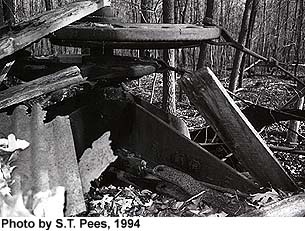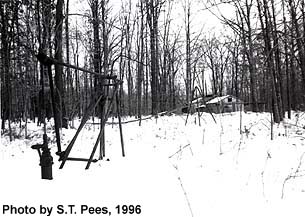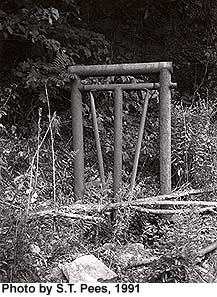|
|
Hookup, Three Poles, Rod Lines
The route of the rod line from the eccentric on the power to the well jack takes all sorts of fittings and supports in order to get there and make the connection. Stirrups, grip couplings, clevises, yokes, straps, o-rings, hooks, throw-off hooks, rod clamps, pendulums, are a few of them that have direct contact with the rod lines. A few of these items are pictured below.
The rods are supported variously by metal tripods, wooden three-poles, bipods with slant or vertical legs (for overhead or under-road passage), rod carriers (usually of wood and with a metal sheave), and devices for 90 degree turns (swing arounds). Instead of rod lines, wire rope is sometimes used and this requires a different design for some of the parts. Very early rods were made of wood, called shackles. The term shackle work is still used occasionally to refer to the myriad fittings required by rod lines connected to powers.
Following one of the rod lines is an exciting adventure. It may take you to the well, or, if you started near that end and walked the other way, the rod line will take you to the power. There can be surprises enroute. Hazards and complications are surmounted by ingenious devices and hookups. The direction from the power to the well may not be a straight line, although it usually is. Occasionally a well in an awkward position is reached by a swing arrangement which, if necessary, can actuate a ninety degree turn to a hook-up. Another surprise is that the rod line may go underground to get through (instead of over) an embankment such as a railroad bed or any narrow ridge that doesn't reach bed rock. In going through topography like that, a pipe or casing is driven horizontally through the rise, and the rod line threads through the pipe. In the case of vehicular roads, the rod line is either taken high over the road (above truck height) or underneath it in a culvert. The latter requires a bipod with an underslung arrangement to support the low rod line, one bipod on either side of the road. In Oil Creek Valley and environs, two generations of these underslung bipods can be seen. Some old wooden ones still survive but are going fast. Metal bipods can be seen in the valley, but the rod lines which they support have been motionless for a long time.
 |
 |
 |
From out-of-print Jarecki and National Supply Catalogs (see Bibliography).
|
|
|
 |
Two rod line connections to the eccentrics still survive at this abandoned Simplex power.
|
|
|
 |
Two tripods carry the rod line from the power (background) to the well jack at left. This is a working power.
|
|
|
 |
A row of tripods carry a working rod line to a well jack. The pendulum is visible in the nearest tripod. The rod line rests in the hook of the pendulum.
|
|
|
 |
These tripods were never intended to support a falling building but that is exactly what is happening. The pipe legs and some saplings are holding up a corrugated wall of an abandoned power. The previous operator rigged up an odd number of fittings on the rod line (left) including a C link (disconnecting link) which apparently served for whatever he intended. Improvisation was standard methodology in the oilfields. Parts made for one purpose would often serve for another.
|
|
|
 |
A bipod intended to carry a rod line over a dirt road. It no longer serves this purpose. The bipod is in Wildcat Hollow near Petroleum Centre (ghost town) in Oil Creek Valley.
|
|
|
 |
This underslung device originally carried a rod line into a culvert and underneath a road.
|
|
|
 |
This is an o-ring connection. A small clamp stirrup is on the rod line at right. The clamp device at the left has a special bend in the stirrups. The ring must have been used for a long time and in another arrangement. You can see the worn "bite" in the left side of the ring. A pendulum holds the o-ring up. It is supported by a bipod which allows the rod line to be close to the ground, a situation desired by the operator years ago.
|
|
|
 |
Only one rod line comes out on this side of the power. A grip coupling holds on to the line and a stirrup of some sort.
|
|
|
 |
This is a wooden three-pole. It still has a pendulum in place, but the rod line is on the ground. These three-poles are venerable artifacts of the oilscape. If made of chestnut, they would last a long time.
|
|
|

![]()











